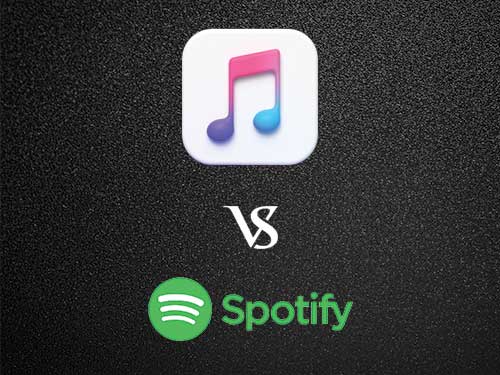Intellectual Property Rights (IPR) are like different keys for different locks. Just like every lock…
Apple Music V. Spotify: A Comparative Study In The Digital Music Marketplace (Part ii)
SPOTIFY
Spotify is an on-demand music streaming service that allows users to browse a database of music licensed through different record labels, as well as create and share playlists with other Spotify users. It has 70 million songs on its servers, all of which are saved on its own servers. Users had three subscription options at first: free, unlimited, and premium. Unlimited would cost €5 from its users, while premium would cost €10. The unlimited membership offer is no longer available on the site, although it did remove advertisements, which was the main difference between it and the free version. It did not, however, allow offline content to be viewed on any device. Although the service is well-liked by its customers, some artists’ relationships with Spotify have sparked debate in the media.
APPLE MUSIC
Apple Music is based on the already popular iTunes Store, which has a vast user base. Users were initially given the option of signing up for a free trial, after which they would be charged €10 per month for the service, or leaving and ending their access to the music streaming service. Artists/Musicians favor Apple’s service since it is a subscription-based service that pays artists during the three-month free trial period.
COMPARATIVE IMPACT ANALYSIS: SPOTIFY V. APPLE MUSIC
Technology advancements have caused the music sector to rethink its current
-
Subscription model: Freemium v. Premium controversy
When your song is played on digital services like Spotify and Apple Music, both performance and mechanical royalties are produced because a music stream is considered both a public performance and a mechanical replication of your work. The amount paid for a Spotify stream varies depending on the country and kind of user (premium, free, family, student, etc.).In terms of subscription, Spotify provides its users with a freemium- ad-supported model along with the premium model. It also allowed an unlimited subscription model initially, however, it has removed it now. The elimination of unlimited may be interpreted as Spotify attempting to encourage more customers to subscribe to the premium service by removing the intermediate option. Users must either pay to receive unlimited music on any device with no distractions, or they are subjected to commercials. In fact, the freemium model also depicts one of the business strategies of Spotify to attract its users towards its premium packages as one would always prefer uninterrupted ad-free service while listening to music.
Apple, on the other hand, operates on a paid service model which gives its users an uninterrupted ad-free experience, and the users could browse through various catalogs of music with premium access. Apple Music has been against the freemium model as it believes it does not bring revenue to the music industry through advertising. Despite the fact that streaming services like Spotify pay more than 70% of income to rights holders, the fact that its service is free gives users the impression that music is inexpensive. While Spotify has grown its users over time attracting consumers through its freemium model, Apple music on the other hand has proven to be artist-friendly due to its premium model.
-
Royalty payments: Artists’ rights
According to the sources, Spotify buys a license from labels, artists, publishers, and other rights holders in exchange for the right to stream their music on its platform. The software uses complicated algorithms to calculate the fee per stream for each artist or label before paying them. To compute royalties per stream, the platform considers parameters such as the country in which the song is played, the country’s currency value, contracts, artist worth, and so on. According to some statistics, the average “per-stream payout” to rights holders on Spotify ranges from $0.003 to $0.005. Unless the artist owns “his or her master recordings,” which averages roughly $0.0004 each Spotify stream, Spotify pays “back seventy percent in royalties,” which in most cases go to the record label or distributor (Swanson, 2013). Over the previous decade, musicians have criticized Spotify, claiming that they do not make enough money from their Spotify plays. They believe this is related to Spotify’s policy of giving subscribers free music.
The case of Taylor Swift, Beyonce, and others
Taylor Swift, the “Shake It Off” singer, withdrew her songs off Spotify in 2014, despite being one of the service’s most successful artists, after criticizing the fact that artists only receive a little fee per song played. Her back catalog was taken off from Spotify just before the release of her 1989 album on Apple Music, which was expected to sell over a million copies and so earn platinum certification. It outperformed predictions, selling over 1.287 million copies in its first week, with no streams from music sites counted. Similarly, Beyonce, after releasing her latest album, in late 2013, blocked it from streaming for nearly a year. When Adele released her latest album, “21,” in 2011, she was one of a handful of famous acts to do so. It was offered for sale on CD and iTunes, but it wasn’t made accessible for free streaming until a month or two after initial sales peaked. After being removed off from Spotify for more than a year, the album went on to sell more than 30 million copies worldwide. All of these artists believed that the freemium model, championed by Spotify, allows consumers to listen to music for free for as long as they like in the hopes that they will purchase subscriptions to remove commercials and receive other benefits.
On the other hand, Apple pays its artists twice as much in royalties as Spotify does on a “per stream play” basis. Apple has recently officially acknowledged that it pays a 52 percent net revenue share to recorded music rights holders (“all labels”), according to its section of the newsletter. This is the same net revenue share that Spotify now pays to the big labels. In 2017, Spotify lowered its headline rate from 55 percent to 52 percent, and Apple Music appears to have done the same in its most recent round of negotiations, which occurred in the same year. In the case of Spotify, the situation is more nuanced, with some independents saying they get paid less than 52 percent effective due to contractual reductions and discounts. Apple has been careful to specify that $0.01 per stream is the average payout from its individual paid plans, indicating that it has left out its discounted bundles (such as its $14.99-per-month Family subscription for up to six people; its multimedia Apple One subscription; or its $4.99-per-month Student subscription), which is one of its business strategies. Spotify had 155 million users by the end of 2020, which, unlike Apple Music, benefits from an ad-funded (‘free’) tier that it leverages as a ‘funnel’ to upsell customers into Premium. In general, Apple appears to be more artist-friendly, owing to its use of a variety of business tactics to compensate artists. Spotify, on the other hand, has been delaying in terms of royalty payments to its musicians, as a number of artists have accused the company of doing so, and some have even pulled their catalog from the service. Musicians favor Apple’s service because it is a subscription-only service that pays musicians during the three-month free trial period.
CONCLUSION
Changes brought in by new technologies, most recently the widespread use of the Internet and other digital technologies, which have revolutionized every aspect of the music industry from composition, performance, and recording to distribution, promotion, and listening, have had an impact on how those who own rights to a musical work are compensated. Even as the music industry has stabilized in this regard, the introduction and success of music streaming services like Spotify has posed new issues that the industry is only now beginning to confront. The two main concerns that popped up while analyzing this debate are the licensing system of these music streaming services and the revamping of their business models. Since services such as Spotify, as substantiated in various instances above, chose expediency above licenses by selling music to members without negotiating direct licenses from the copyright owners or pursuing compulsory licenses, the artists are reluctant to sign licensing deals with such streaming services due to fear of little or no payment of royalties. Apple Music, on the other hand, has proved to be great in this regard. Along with the licensing deals, these music streaming services also need to work towards their business models. Spotify will have to do something to raise the number of paying members if the popularity of alternative streaming services such as Apple music, that do not offer a free service, continues to grow. It is because most artists believe that it is because of its freemium model, the service does not generate enough revenue and ultimately it fails to pay royalties to the artists. Although, Apple music pays their artists on the basis of “penny per stream”, the question that arises is whether it is a good target to aim for and if so, how do DSPs work towards it, including those with free, ad-supported tiers? And most importantly, how do we make sure those pennies then flow through the system efficiently and fairly, to ensure musicians and music companies alike can thrive? It is therefore pertinent for the policymakers to come up with a mechanism with regards to these music streaming services, in the current copyright regime to ensure payment of royalties to the copyright holder fairly and efficiently.
Author: Anuja Saraswat – a student of NMIMS, Kirit P. Mehta School of Law, (Mumbai ), in case of any queries please contact/write back to us at Khurana & Khurana, Advocates and IP Attorney or via email vidushi@khuranaandkhurana.com



